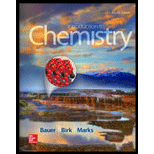
(a)
Interpretation:
The balanced nuclear reaction for the given nuclear reaction is to be determined
(a)
Explanation of Solution
A nuclear reaction involves changes at the subatomic level such as, the changes in the number of protons, the number of neutrons, or the energy state. To balance a nuclear reaction, two conservation conditions can be used, conservation of mass number and conservation of charges (atomic number).
The given reaction is as follows.
Where,
Apply the conservation conditions for mass numbers and
Balance the mass numbers.
The sum of mass numbers of reactants is equal to the sum of mass numbers of products.
Similarly, balance the atomic numbers. The sum of atomic numbers of reactants is equal to the sum of atomic numbers of products.
Therefore, the reactant,
Hence, the balanced reaction can be written as,
(b)
Interpretation:
The balanced nuclear reaction for the given nuclear reaction is to be determined
(b)
Explanation of Solution
The given reaction is as follows.
Where,
Apply the conservation conditions for mass numbers and atomic numbers to identify the product,
Balance the mass numbers.
The sum of mass numbers of reactants is equal to the sum of mass numbers of the products.
Similarly, balance the atomic numbers.
The sum of atomic numbers of reactants is equal to the sum of atomic numbers of products.
As the charge is
Hence, the balanced reaction can be written as,
(c)
Interpretation:
The balanced nuclear reaction for the given nuclear reaction is to be determined
(c)
Explanation of Solution
The given reaction is as follows.
Where,
Apply the conservation conditions for mass numbers and atomic numbers to identify the product,
Balance the mass numbers. The sum of mass numbers of reactants is equal to the sum of mass numbers of products.
Similarly, balance the atomic numbers. The sum of atomic numbers of reactants is equal to the sum of atomic numbers of products.
Therefore, the product,
(d)
Interpretation:
The balanced nuclear reaction for the given nuclear reaction is to be determined
(d)
Explanation of Solution
The given reaction is as follows.
Where,
Apply the conservation conditions for mass numbers and atomic numbers to identify the product,
Balance the mass numbers, the sum of mass numbers of reactants is equal to the sum of mass numbers of products.
Similarly, balance the atomic numbers. The sum of atomic numbers of reactants is equal to the sum of atomic numbers of products.
Therefore, the reactant,
Want to see more full solutions like this?
Chapter 15 Solutions
Introduction to Chemistry
- What chemical is described as 1MH2SO4?arrow_forwardWhat do 14C+ , 15N, and 17F- have in common? the same number of electrons the same number of neutrons the same size the same number of protonsarrow_forwardWhether or not the process is observed in Nature, which of the following could account for the transformation of carbon-10 to boron-10?arrow_forward
- What is the abundance of beryllium-10 ?arrow_forwardFrom experiments on alpha particle scattering from thin films of gold, the nuclear centers of gold atoms are about 1.32 × 10–14 m in diameter and are about 292 pm apart. How many gold atoms line up across a 600.0 nm thin film?arrow_forward2-73 (Chemical Connections 2D) Copper is a soft metal. how can it be made harder?arrow_forward
 Chemistry: An Atoms First ApproachChemistryISBN:9781305079243Author:Steven S. Zumdahl, Susan A. ZumdahlPublisher:Cengage Learning
Chemistry: An Atoms First ApproachChemistryISBN:9781305079243Author:Steven S. Zumdahl, Susan A. ZumdahlPublisher:Cengage Learning
 ChemistryChemistryISBN:9781305957404Author:Steven S. Zumdahl, Susan A. Zumdahl, Donald J. DeCostePublisher:Cengage Learning
ChemistryChemistryISBN:9781305957404Author:Steven S. Zumdahl, Susan A. Zumdahl, Donald J. DeCostePublisher:Cengage Learning Introduction to General, Organic and BiochemistryChemistryISBN:9781285869759Author:Frederick A. Bettelheim, William H. Brown, Mary K. Campbell, Shawn O. Farrell, Omar TorresPublisher:Cengage Learning
Introduction to General, Organic and BiochemistryChemistryISBN:9781285869759Author:Frederick A. Bettelheim, William H. Brown, Mary K. Campbell, Shawn O. Farrell, Omar TorresPublisher:Cengage Learning General Chemistry - Standalone book (MindTap Cour...ChemistryISBN:9781305580343Author:Steven D. Gammon, Ebbing, Darrell Ebbing, Steven D., Darrell; Gammon, Darrell Ebbing; Steven D. Gammon, Darrell D.; Gammon, Ebbing; Steven D. Gammon; DarrellPublisher:Cengage Learning
General Chemistry - Standalone book (MindTap Cour...ChemistryISBN:9781305580343Author:Steven D. Gammon, Ebbing, Darrell Ebbing, Steven D., Darrell; Gammon, Darrell Ebbing; Steven D. Gammon, Darrell D.; Gammon, Ebbing; Steven D. Gammon; DarrellPublisher:Cengage Learning Chemistry for Today: General, Organic, and Bioche...ChemistryISBN:9781305960060Author:Spencer L. Seager, Michael R. Slabaugh, Maren S. HansenPublisher:Cengage Learning
Chemistry for Today: General, Organic, and Bioche...ChemistryISBN:9781305960060Author:Spencer L. Seager, Michael R. Slabaugh, Maren S. HansenPublisher:Cengage Learning





